Abstract
Diaphragm atrophy and weakness occur after administration of massive doses of corticosteroids for short periods. In the present study the effects of prolonged administration of moderate doses of fluorinated and nonfluorinated steroids were investigated on contractile properties and histopathology of rat diaphragm. 60 rats received saline, 1.0 mg/kg triamcinolone, or 1.25 or 5 mg/kg i.m. prednisolone daily for 4 wk. Respiratory and peripheral muscle mass increased similarly in control and both prednisolone groups, whereas triamcinolone caused severe muscle wasting. Maximal tetanic tension averaged 2.23 +/- 0.54 kg/cm2 (SD) in the control group. An increased number of diaphragmatic bundles in the 5-mg/kg prednisolone group generated maximal tetanic tensions < 2.0 kg/cm2 (P < 0.05). In addition, fatigability during the force-frequency protocol was most pronounced in this group (P < 0.05). In contrast, triamcinolone caused a prolonged half-relaxation time and a leftward shift of the force-frequency curve (P < 0.05). Histological examination of the diaphragm showed a normal pattern in the control and 1.25-mg/kg prednisolone group. Myogenic changes, however, were found in the 5-mg/kg prednisolone group and, more pronounced, in the triamcinolone group. Selective type IIb fiber atrophy was found in the latter group, but not in the prednisolone groups. In conclusion, triamcinolone induced type IIb fiber atrophy, resulting in reduced respiratory muscle strength and a leftward shift of the force-frequency curve. In contrast, 5 mg/kg prednisolone caused alterations in diaphragmatic contractile properties and histological changes without fiber atrophy.
Full text
PDF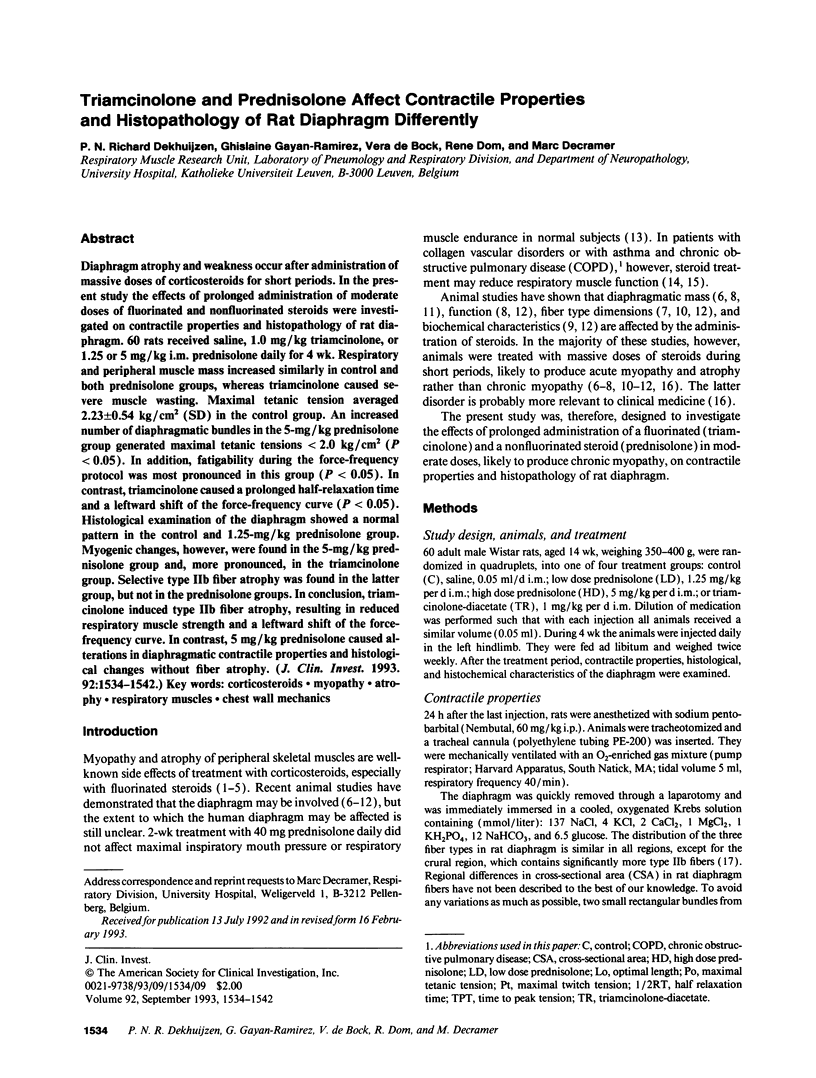
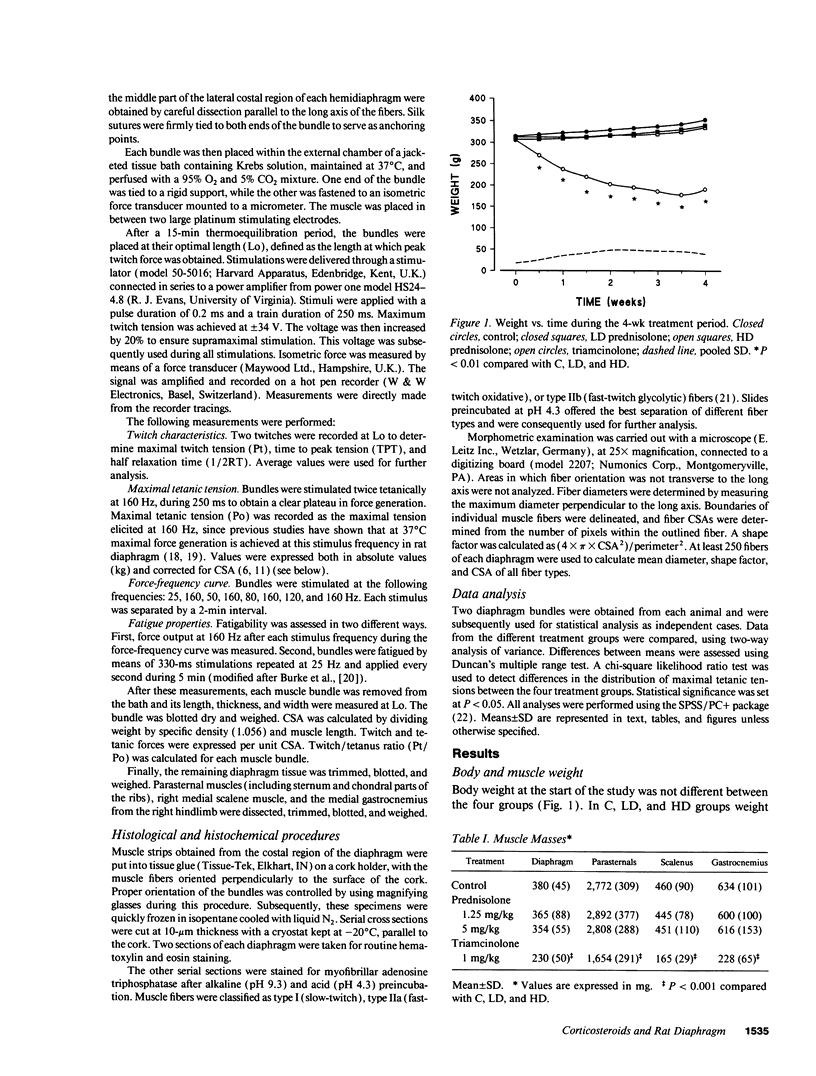
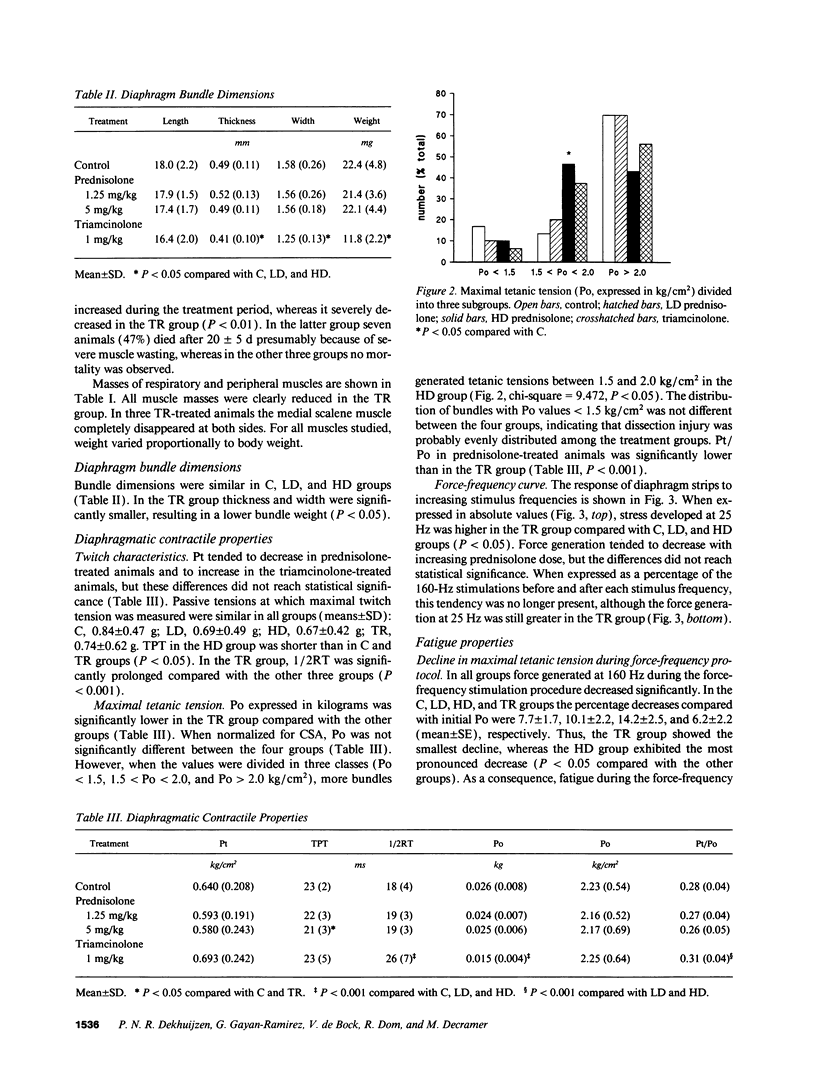
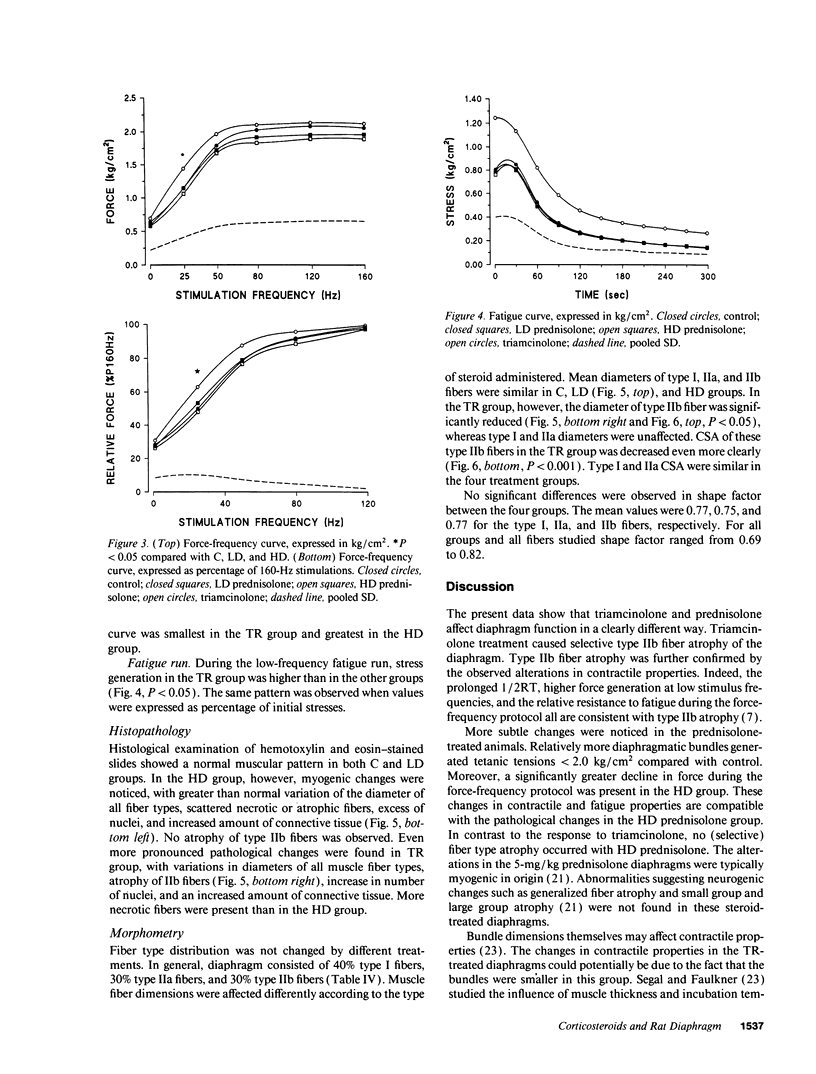
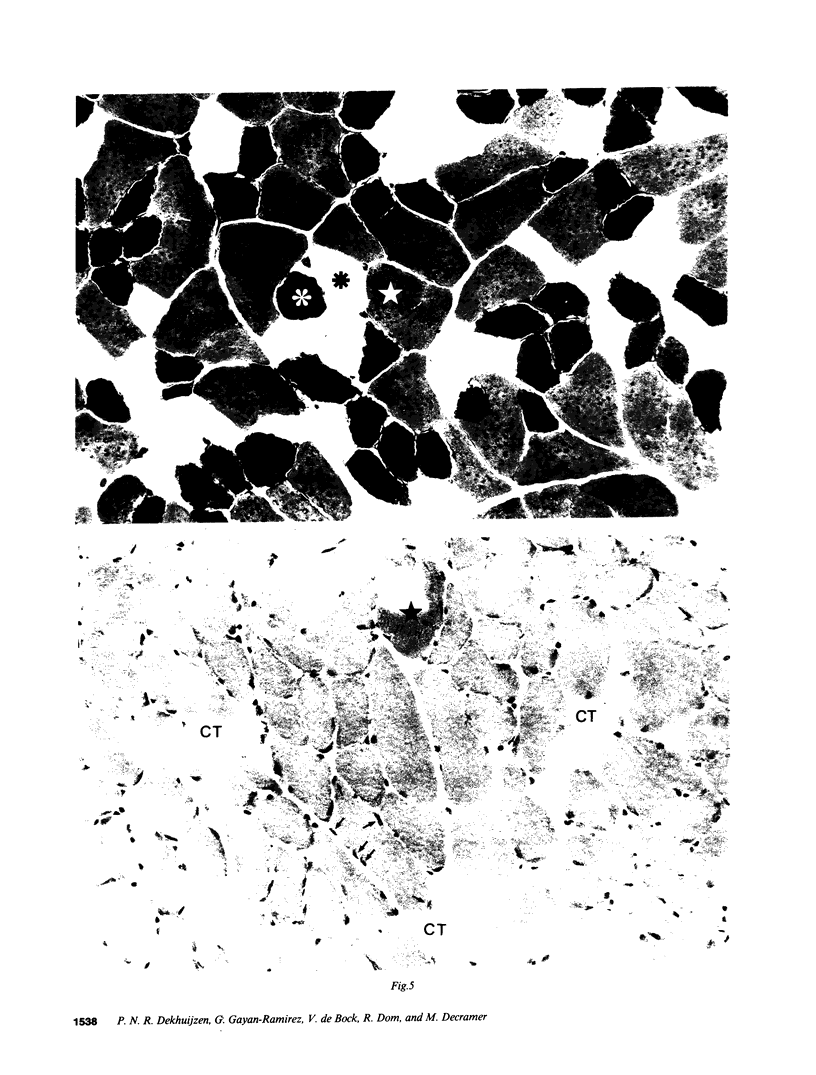
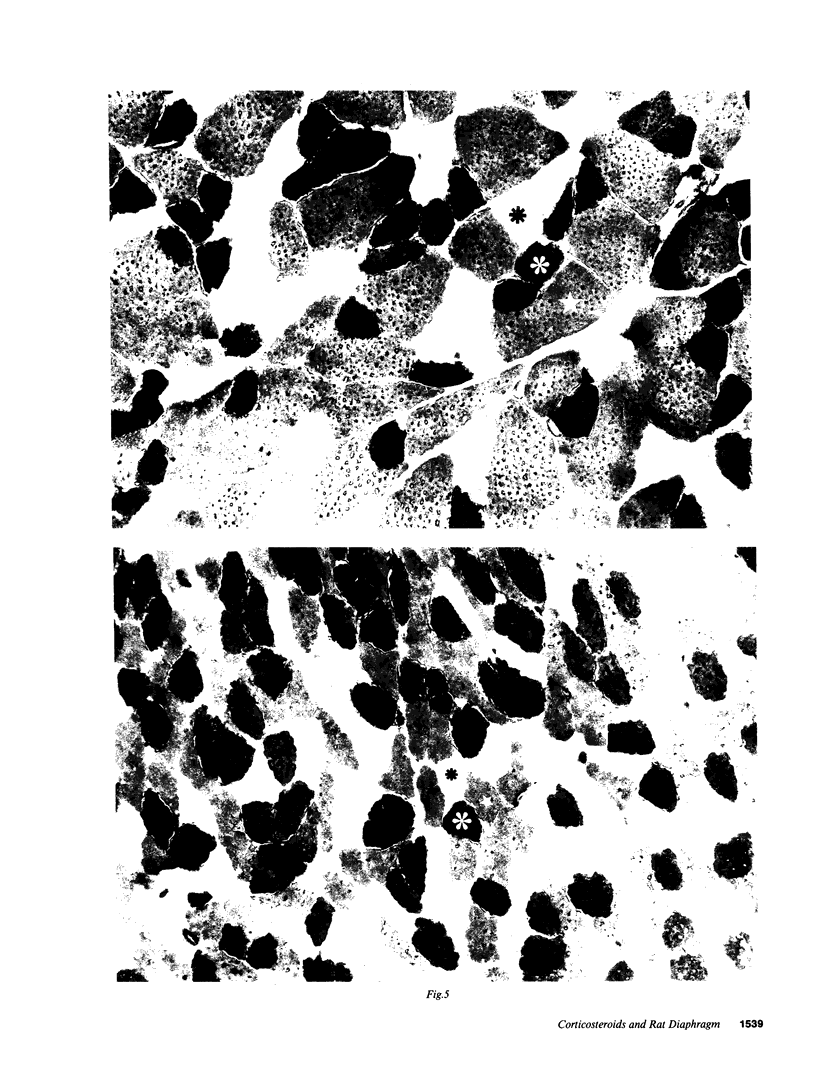
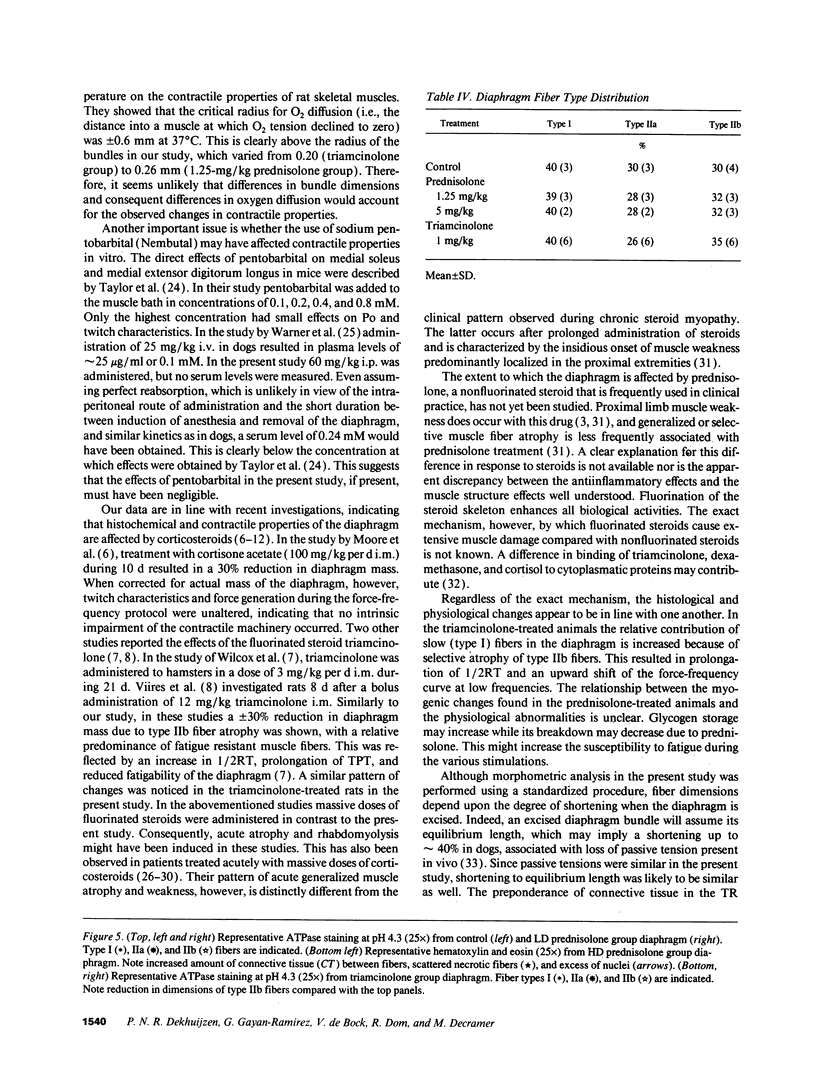
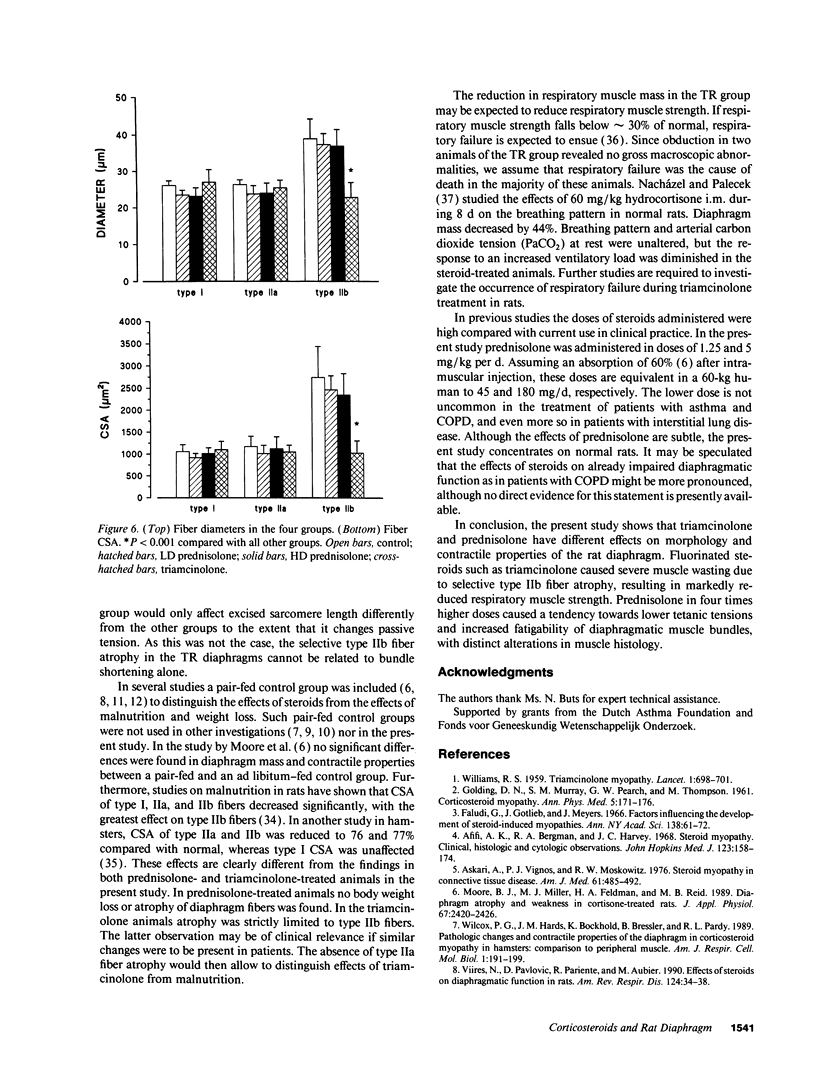
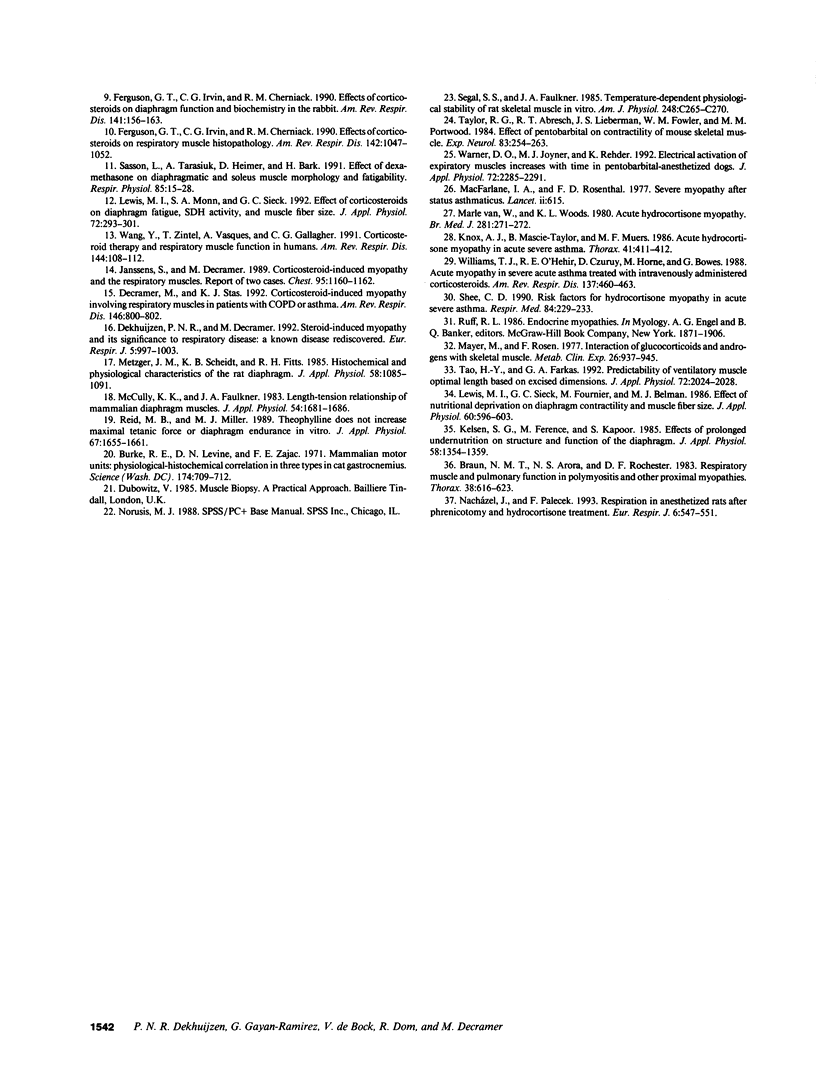
Images in this article
Selected References
These references are in PubMed. This may not be the complete list of references from this article.
- Afifi A. K., Bergman R. A., Harvey J. C. Steroid myopathy. Clinical, histologic and cytologic observations. Johns Hopkins Med J. 1968 Oct;123(4):158–173. [PubMed] [Google Scholar]
- Askari A., Vignos P. J., Jr, Moskowitz R. W. Steroid myopathy in connective tissue disease. Am J Med. 1976 Oct;61(4):485–492. doi: 10.1016/0002-9343(76)90327-2. [DOI] [PubMed] [Google Scholar]
- Braun N. M., Arora N. S., Rochester D. F. Respiratory muscle and pulmonary function in polymyositis and other proximal myopathies. Thorax. 1983 Aug;38(8):616–623. doi: 10.1136/thx.38.8.616. [DOI] [PMC free article] [PubMed] [Google Scholar]
- Burke R. E., Levine D. N., Zajac F. E., 3rd Mammalian motor units: physiological-histochemical correlation in three types in cat gastrocnemius. Science. 1971 Nov 12;174(4010):709–712. doi: 10.1126/science.174.4010.709. [DOI] [PubMed] [Google Scholar]
- Decramer M., Stas K. J. Corticosteroid-induced myopathy involving respiratory muscles in patients with chronic obstructive pulmonary disease or asthma. Am Rev Respir Dis. 1992 Sep;146(3):800–802. doi: 10.1164/ajrccm/146.3.800. [DOI] [PubMed] [Google Scholar]
- Dekhuijzen P. N., Decramer M. Steroid-induced myopathy and its significance to respiratory disease: a known disease rediscovered. Eur Respir J. 1992 Sep;5(8):997–1003. [PubMed] [Google Scholar]
- Faludi G., Gotlieb J., Meyers J. Factors influencing the development of steroid-induced myopathies. Ann N Y Acad Sci. 1966 Sep 9;138(1):62–72. [PubMed] [Google Scholar]
- Ferguson G. T., Irvin C. G., Cherniack R. M. Effect of corticosteroids on diaphragm function and biochemistry in the rabbit. Am Rev Respir Dis. 1990 Jan;141(1):156–163. doi: 10.1164/ajrccm/141.1.156. [DOI] [PubMed] [Google Scholar]
- Ferguson G. T., Irvin C. G., Cherniack R. M. Effect of corticosteroids on respiratory muscle histopathology. Am Rev Respir Dis. 1990 Nov;142(5):1047–1052. doi: 10.1164/ajrccm/142.5.1047. [DOI] [PubMed] [Google Scholar]
- GOLDING D. N., MURRAY S. M., PEARCE G. W., THOMPSON M. Corticosteroid myopathy. Ann Phys Med. 1961 Nov;6:171–177. doi: 10.1093/rheumatology/6.4.171. [DOI] [PubMed] [Google Scholar]
- Janssens S., Decramer M. Corticosteroid-induced myopathy and the respiratory muscles. Report of two cases. Chest. 1989 May;95(5):1160–1162. doi: 10.1378/chest.95.5.1160. [DOI] [PubMed] [Google Scholar]
- Kelsen S. G., Ference M., Kapoor S. Effects of prolonged undernutrition on structure and function of the diaphragm. J Appl Physiol (1985) 1985 Apr;58(4):1354–1359. doi: 10.1152/jappl.1985.58.4.1354. [DOI] [PubMed] [Google Scholar]
- Knox A. J., Mascie-Taylor B. H., Muers M. F. Acute hydrocortisone myopathy in acute severe asthma. Thorax. 1986 May;41(5):411–412. doi: 10.1136/thx.41.5.411. [DOI] [PMC free article] [PubMed] [Google Scholar]
- Lewis M. I., Monn S. A., Sieck G. C. Effect of corticosteroids on diaphragm fatigue, SDH activity, and muscle fiber size. J Appl Physiol (1985) 1992 Jan;72(1):293–301. doi: 10.1152/jappl.1992.72.1.293. [DOI] [PubMed] [Google Scholar]
- Lewis M. I., Sieck G. C., Fournier M., Belman M. J. Effect of nutritional deprivation on diaphragm contractility and muscle fiber size. J Appl Physiol (1985) 1986 Feb;60(2):596–603. doi: 10.1152/jappl.1986.60.2.596. [DOI] [PubMed] [Google Scholar]
- MacFarlane I. A., Rosenthal F. D. Severe myopathy after status asthmaticus. Lancet. 1977 Sep 17;2(8038):615–615. doi: 10.1016/s0140-6736(77)91471-4. [DOI] [PubMed] [Google Scholar]
- Mayer M., Rosen F. Interaction of glucocorticoids and androgens with skeletal muscle. Metabolism. 1977 Aug;26(8):937–962. doi: 10.1016/0026-0495(77)90013-0. [DOI] [PubMed] [Google Scholar]
- McCully K. K., Faulkner J. A. Length-tension relationship of mammalian diaphragm muscles. J Appl Physiol Respir Environ Exerc Physiol. 1983 Jun;54(6):1681–1686. doi: 10.1152/jappl.1983.54.6.1681. [DOI] [PubMed] [Google Scholar]
- Metzger J. M., Scheidt K. B., Fitts R. H. Histochemical and physiological characteristics of the rat diaphragm. J Appl Physiol (1985) 1985 Apr;58(4):1085–1091. doi: 10.1152/jappl.1985.58.4.1085. [DOI] [PubMed] [Google Scholar]
- Moore B. J., Miller M. J., Feldman H. A., Reid M. B. Diaphragm atrophy and weakness in cortisone-treated rats. J Appl Physiol (1985) 1989 Dec;67(6):2420–2426. doi: 10.1152/jappl.1989.67.6.2420. [DOI] [PubMed] [Google Scholar]
- Nacházel J., Palecek F. Respiration after phrenicotomy and hydrocortisone treatment in anaesthetized rats. Eur Respir J. 1993 Apr;6(4):547–551. [PubMed] [Google Scholar]
- Reid M. B., Miller M. J. Theophylline does not increase maximal tetanic force or diaphragm endurance in vitro. J Appl Physiol (1985) 1989 Oct;67(4):1655–1661. doi: 10.1152/jappl.1989.67.4.1655. [DOI] [PubMed] [Google Scholar]
- Sasson L., Tarasiuk A., Heimer D., Bark H. Effect of dexamethasone on diaphragmatic and soleus muscle morphology and fatigability. Respir Physiol. 1991 Jul;85(1):15–28. doi: 10.1016/0034-5687(91)90003-2. [DOI] [PubMed] [Google Scholar]
- Segal S. S., Faulkner J. A. Temperature-dependent physiological stability of rat skeletal muscle in vitro. Am J Physiol. 1985 Mar;248(3 Pt 1):C265–C270. doi: 10.1152/ajpcell.1985.248.3.C265. [DOI] [PubMed] [Google Scholar]
- Shee C. D. Risk factors for hydrocortisone myopathy in acute severe asthma. Respir Med. 1990 May;84(3):229–233. doi: 10.1016/s0954-6111(08)80040-6. [DOI] [PubMed] [Google Scholar]
- Tao H. Y., Farkas G. A. Predictability of ventilatory muscle optimal length based on excised dimensions. J Appl Physiol (1985) 1992 May;72(5):2024–2028. doi: 10.1152/jappl.1992.72.5.2024. [DOI] [PubMed] [Google Scholar]
- Taylor R. G., Abresch R. T., Lieberman J. S., Fowler W. M., Jr, Portwood M. M. Effect of pentobarbital on contractility of mouse skeletal muscle. Exp Neurol. 1984 Feb;83(2):254–263. doi: 10.1016/S0014-4886(84)90096-7. [DOI] [PubMed] [Google Scholar]
- Van Marle W., Woods K. L. Acute hydrocortisone myopathy. Br Med J. 1980 Jul 26;281(6235):271–272. doi: 10.1136/bmj.281.6235.271-a. [DOI] [PMC free article] [PubMed] [Google Scholar]
- Viires N., Pavlovic D., Pariente R., Aubier M. Effects of steroids on diaphragmatic function in rats. Am Rev Respir Dis. 1990 Jul;142(1):34–38. doi: 10.1164/ajrccm/142.1.34. [DOI] [PubMed] [Google Scholar]
- WILLIAMS R. S. Triamcinolone myopathy. Lancet. 1959 Apr 4;1(7075):698–701. doi: 10.1016/s0140-6736(59)91885-9. [DOI] [PubMed] [Google Scholar]
- Wang Y. M., Zintel T., Vasquez A., Gallagher C. G. Corticosteroid therapy and respiratory muscle function in humans. Am Rev Respir Dis. 1991 Jul;144(1):108–112. doi: 10.1164/ajrccm/144.1.108. [DOI] [PubMed] [Google Scholar]
- Warner D. O., Joyner M. J., Rehder K. Electrical activation of expiratory muscles increases with time in pentobarbital-anesthetized dogs. J Appl Physiol (1985) 1992 Jun;72(6):2285–2291. doi: 10.1152/jappl.1992.72.6.2285. [DOI] [PubMed] [Google Scholar]
- Wilcox P. G., Hards J. M., Bockhold K., Bressler B., Pardy R. L. Pathologic changes and contractile properties of the diaphragm in corticosteroid myopathy in hamsters: comparison to peripheral muscle. Am J Respir Cell Mol Biol. 1989 Sep;1(3):191–199. doi: 10.1165/ajrcmb/1.3.191. [DOI] [PubMed] [Google Scholar]
- Williams T. J., O'Hehir R. E., Czarny D., Horne M., Bowes G. Acute myopathy in severe acute asthma treated with intravenously administered corticosteroids. Am Rev Respir Dis. 1988 Feb;137(2):460–463. doi: 10.1164/ajrccm/137.2.460. [DOI] [PubMed] [Google Scholar]






